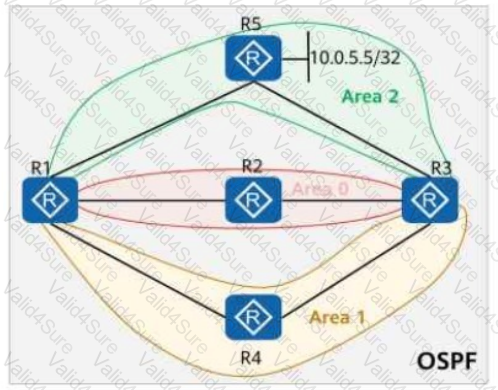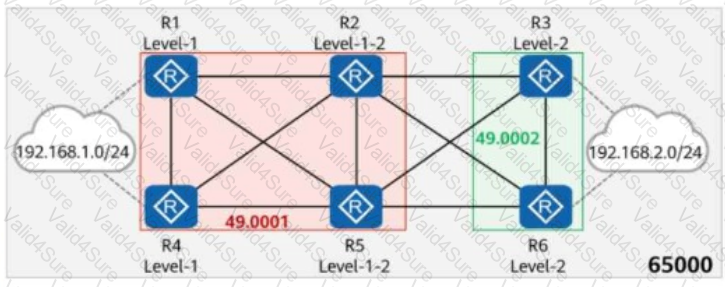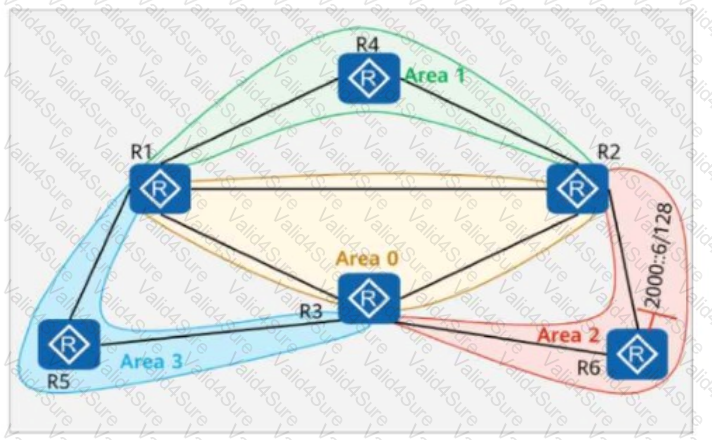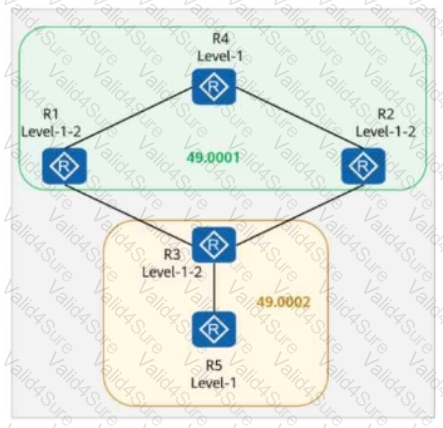H12-831_V1.0 Exam Dumps - HCIP-Datacom-Advanced Routing & Switching Technology V1.0
Searching for workable clues to ace the Huawei H12-831_V1.0 Exam? You’re on the right place! ExamCert has realistic, trusted and authentic exam prep tools to help you achieve your desired credential. ExamCert’s H12-831_V1.0 PDF Study Guide, Testing Engine and Exam Dumps follow a reliable exam preparation strategy, providing you the most relevant and updated study material that is crafted in an easy to learn format of questions and answers. ExamCert’s study tools aim at simplifying all complex and confusing concepts of the exam and introduce you to the real exam scenario and practice it with the help of its testing engine and real exam dumps
On the OSPF network shown in the figure, area 1 and area 2 are common areas. The IP address of Loopback0 on R5 is 10.0.5.5/32, and OSPF is enabled on this interface. If the abr-summary 10.0.5.0 255.255.255.0 command is run in area 2 (where R1 resides), which of the following routers have the route 10.0.5.0/24 in their routing tables?

On the network shown in the figure, single-hop BFD is configured on R1 and R2.
A network engineer finds that the BFD session goes down. To locate the fault, the network engineer queries the BFD configurations on R1 and R2.
According to the configuration information marked in the figure, it can be determined that mismatched time parameter settings on R1 and R2 cause the BFD session to go down.

Is this statement TRUE or FALSE?
On the network shown in the figure, IS-IS runs on R1, R2, R4, and R5, and the area ID is 49.0001. IS-IS runs on R3 and R6, and the area ID is 49.0002. The import-route isis level-2 into level-1 command is configured on R2.
In AS 65000, R1, R3, R4, and R6 each establish iBGP peer relationships with R2 and R5. R2 and R5 are Route Reflectors (RRs), and R1, R4, R3, and R6 are clients.
An iBGP peer relationship is established between R2 and R5, and the same cluster ID is configured. The iBGP peer relationships are established using Loopback0. The IP address of Loopback0 on each router is 10.0.X.X/32, where X is the router number.
R1 and R4 import the external route 192.168.1.0/24 to BGP through the import-route command, and R3 and R6 import the external route 192.168.2.0/24 to BGP through the import-route command.

Which of the following statements are true?
Network administrators can run the clock timezone command to set the time zone of a device. If two network devices have different time zone settings, they cannot establish a neighbor relationship using a dynamic routing protocol.
Options:
On the OSPFv3 network shown in the figure:
Area 1 is a stub area, Area 2 is a common area, and Area 3 is an NSSA (Not-So-Stubby Area).
The IPv6 address of Loopback0 on R6 is 2000::6/128.
The router ID of each router is 10.0.X.X, where X is the router number.
The stub no-summary command is configured in Area 1 on R2.
Which of the following statements is true?

On the IS-IS IPv6 network shown in the figure, multi-topology is enabled on all routers.
The ipv6 default-route-advertise always level-1 command is configured in the IS-IS process of R4.

Which of the following routers does not have the default route in its routing table?
If the display ospfv3 peer verbose command is run to check OSPFv3 neighbor information, the command output contains information such as the peer router ID, global unicast address of the peer interface, and neighbor status.
On the network shown in the figure, EBGP peer relationships are established between neighboring routers through directly connected interfaces. The AS number is 6500X, where X is the number of the router. Both Rl and R4 have static routes to 192.168.1.0/24, which are imported to BGP through the import-route command. By default, in the routing table of R3, which of the following is the AS_Path attribute carried in the route to 192.168.1.0/24?